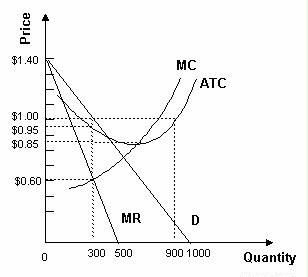Why should I choose AnalystNotes?
Simply put: AnalystNotes offers the best value and the best product available to help you pass your exams.
Basic Question 3 of 4
Refer to the graph below. The monopolistically competitive firm is currently producing 300 units of output. The firm is in ______
B. short-run equilibrium because price exceeds average total cost at the profit-maximizing output level.
C. long-run equilibrium because economic profits are zero at the profit-maximizing output level.

A. both short-run and long-run equilibrium because price exceeds average total cost at the profit-maximizing output level.
B. short-run equilibrium because price exceeds average total cost at the profit-maximizing output level.
C. long-run equilibrium because economic profits are zero at the profit-maximizing output level.
User Contributed Comments 8
| User | Comment |
|---|---|
| danlan | In long-run equilibrium, economic profits are zero. |
| ridone | The price is 1.00 and the average cost is 0.95. |
| CFAonTheBrain | can someone explain the diffrence between short and long run equilibrium again please im a little lost |
| YOUCANDOIT | ^^^ In the short run, equilibrium is achieved as long as firm produces at an output where there MR=MC (ex.300 units). Economic profits are available as long as P>ATC. In the long run, new firms will enter industry if profits are available. As new firms enter the industry, demand for your products will go down. (Think T-shirt companies, if Adidas is a new entrant, demand for Nike T-shirts will go down). D-Curve shifts leftward until P=ATC, where MC=MR and no economic profits are available. |
| YOUCANDOIT | ...as a result, the price and quantity of firm's products demanded will both decrease in this example. |
| Teeto | How do I know the price from the question? |
| fzhou | @Teeto, according to the reading LOS, P1 in the first figure is decided by demand curve. So you take the units given in this question which is 300, find the price point lying on demand curve - this is how you can get the price. |
| Tashen111 | @Teeto Step 1: Look for the value of Q* where MR=MC... This is the Quantity that you will produce your goods at Step 2: Determine the point on the demand curve where you will be producing this quantity Step3: The price in line with that point on the demand curve is the price!!! |

I am using your study notes and I know of at least 5 other friends of mine who used it and passed the exam last Dec. Keep up your great work!

Barnes
Learning Outcome Statements
explain supply and demand relationships under monopolistic competition, including the optimal price and output for firms as well as pricing strategy
CFA® 2024 Level I Curriculum, Volume 1, Module 1.